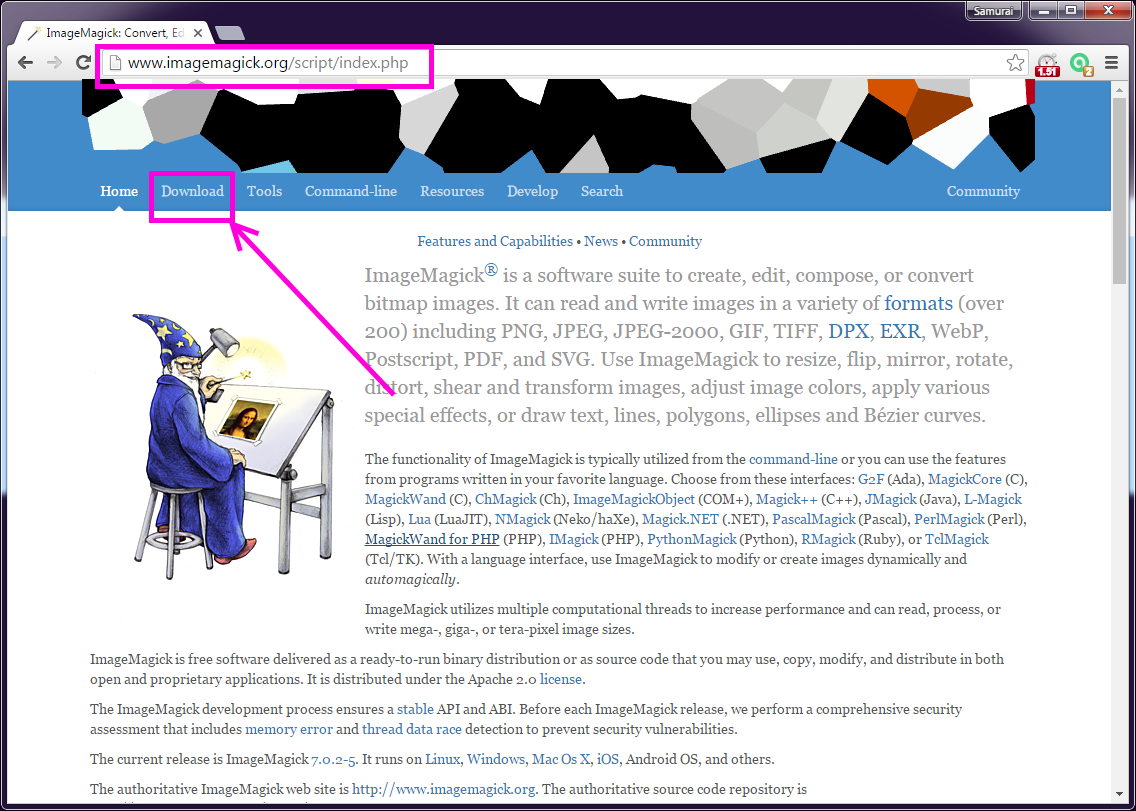Imagemagick Download For Mac
. You can install ImageMagick from. However, if you don't have a proper development environment or if you're anxious to get started, download a ready-to-run or executable. Before you download, you may want to review recent to the ImageMagick distribution. ImageMagick source and binary distributions are available from a variety of FTP and Web around the world. Unix Binary Release These are the Unix variations that we support.
ImageMagick is a collection of mostly command-line based tools that allow you to view, convert and edit graphics files. At the simplest you might just use a command like 'convert image.jpg image.png' to convert an image from one format to another. ImageMagick is a lightweight piece of software that allows provides you with an intuitive environment to create, edit, compose and convert bitmap images. Comes with an outdated interface, but can.
If your system is not on the list, try installing from. Although ImageMagick runs fine on a single core computer, it automagically runs in parallel on dual and quad-core systems reducing run times considerably. Version HTTP FTP Description ImageMagick-x8664-apple-darwin17.7.0.tar.gz MacOS High Sierra Verify its. Create (or choose) a directory to install the package into and change to that directory, for example: cd $HOME Next, extract the contents of the package.
Imagemagick Download Mac Os
For example: tar xvzf ImageMagick-x8664-apple-darwin15.2.0.tar.gz Set the MAGICKHOME environment variable to the path where you extracted the ImageMagick files. For example: $ export MAGICKHOME='$HOME/ImageMagick-6.9.10' If the bin subdirectory of the extracted package is not already in your executable search path, add it to your PATH environment variable. For example: export PATH='$MAGICKHOME/bin:$PATH' Set the DYLDLIBRARYPATH environment variable: export DYLDLIBRARYPATH='$MAGICKHOME/lib/' Finally, to verify ImageMagick is working properly, type the following on the command line: convert logo: logo.gif identify logo.gif display logo.gif Note, the program requires the X11 server available on your Mac OS X installation DVD.
Once that is installed, you will also need to export DISPLAY=:0. The best way to deal with all the exports is to put them at the end of your.profile file Congratulations, you have a working ImageMagick distribution under Mac OS X and you are ready to use ImageMagick to your images or perhaps you'll want to use one of the for C, C, Perl, and others.
IOS Binary Release provides iOS builds of ImageMagick. Download iOS Distribution You can download the iOS distribution directly from ImageMagick's.
There are always 2 packages for the compiled ImageMagick:. iOSMagick-VERSION-libs.zip. iOSMagick-VERSION.zip The first one includes headers and compiled libraries that have been used to compile ImageMagick.
Most users would need this one. ImageMagick compiling script for iOS OS and iOS Simulator To run the script:./imagemagickcompile.sh VERSION where VERSION is the version of ImageMagick you want to compile (i.e.: 6.9.10-14, svn.) This script compiles ImageMagick as a static library to be included in iOS projects and adds support for.

Imagemagick Download Windows
png. jpeg. tiff Upon successful compilation a folder called IMPORTME is created on your /Desktop. You can import it into your Xcode project. Xcode project settings After including everything into Xcode please also make sure to have these settings (Build tab of the project information):. Other Linker Flags: -lMagickCore-Q16 -lMagickWand-Q16 -ljpeg -lpng -lbz2 -lz. Header Search Paths: $(SRCROOT) - make it Recursive.
Library Search Paths: $(SRCROOT) - make it Recursive On the lower left click on the small-wheel and select: Add User-Defined Setting. Key: OTHERCFLAGS. Value: -Dmacintosh=1 Sample project A is available for download. It is not updated too often, but it does give an idea of all the settings and some ways to play around with ImageMagick in an iOS application. Windows Binary Release ImageMagick runs on Windows 10 (x86 & x64), Windows 8 (x86 & x64), Windows 7 (x86 & x64), Windows Server 2012, Windows XP (x86) with Service Pack 3, Windows Vista (x86 & x64) with Service Pack 2, Windows Server 2003 (x86 & x64) with Service Pack 2 (verify MSXML6 is present), Windows Server 2003 R2 (x86 & x64), Windows Server 2008 (x86 & x64) with Service Pack 2, and Windows Server 2008 R2 (x64). The amount of memory can be an important factor, especially if you intend to work on large images.
A minimum of 512 MB of RAM is recommended, but the more RAM the better. Although ImageMagick runs well on a single core computer, it automagically runs in parallel on multi-core systems reducing run times considerably. The Windows version of ImageMagick is self-installing.
Simply click on the appropriate version below and it will launch itself and ask you a few installation questions. Versions with Q8 in the name are 8 bits-per-pixel component (e.g.

8-bit red, 8-bit green, etc.), whereas, Q16 in the filename are 16 bits-per-pixel component. A Q16 version permits you to read or write 16-bit images without losing precision but requires twice as much resources as the Q8 version. Versions with dll in the filename include ImageMagick libraries as. Unless you have a Windows 32-bit OS, we recommend this version of ImageMagick for 64-bit Windows.
Blender is a free software 3D animation program. It can be used for modelling, UV unwrapping, texturing, rigging, skinning, animating, rendering, particle and other simulating, non-linear editing, compositing, and creating interactive 3D applications. OldVersion.com Points System. When you upload software to oldversion.com you get rewarded by points. For every field that is filled out correctly, points will be rewarded, some fields are optional but the more you provide the more you will get rewarded! Old version history of blender 2.28. The last BeOS port, Blender 2.11 Web plugin players On the Past Releases page most recent previous release logs are available, with splash screens and list of features and improvements. Included new default.B.blend file in Blender, with Material, Texture, World and 'draw faces' and 'draw edges' options set. When ButtonsWindow shows Material options (F5), selecting a Lamp automatically switches to Lamp shading settings (F4).